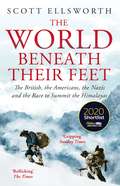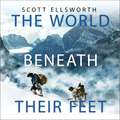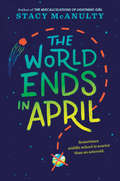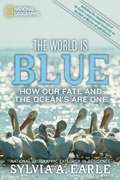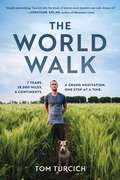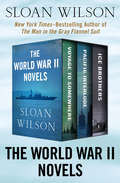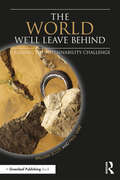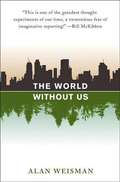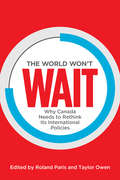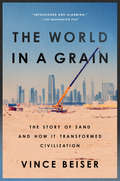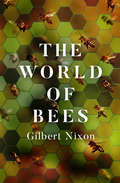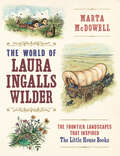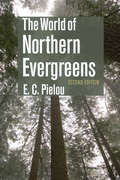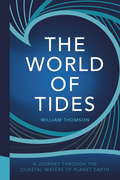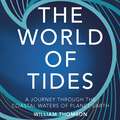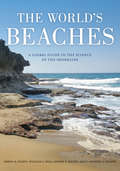- Table View
- List View
The World Beneath Their Feet: The British, the Americans, the Nazis and the Mountaineering Race to Summit the Himalayas
by Scott EllsworthLonglisted for the 2020 William Hill Sports Book of the Year'A gripping history' THE ECONOMIST 'The World Beneath Their Feet contains plenty of rollicking stories' THE TIMES'Gripping' THE SUNDAY TIMES'So far as adventure stories go, this book is tops.' Winston Groom, author of Forrest Gump'[Ellsworth] recasts the era as a great Himalayan race...[and] it works brilliantly...his account of the 1953 ascent of Everest...feels unusually fresh' THE SUNDAY TIMES 'Like if Jon Krakauer's Into Thin Air met Lauren Hillenbrand's Unbroken ... an inviting and engrossing read' SPORTS ILLUSTRATEDOne of the most compelling international dramas of the 20th century and an unforgettable saga of survival, technological innovation, and breathtaking human physical achievement-all set against the backdrop of a world headed toward war.While tension steadily rose between European powers in the 1930s, a different kind of battle was raging across the Himalayas. Contingents from Great Britain, Nazi Germany, and the United States had set up rival camps at the base of the mountains, all hoping to become recognized as the fastest, strongest, and bravest climbers in the world.Carried on across nearly the entire sweep of the Himalayas, this contest involved not only the greatest mountain climbers of the era, but statesmen and millionaires, world-class athletes and bona fide eccentrics, scientists and generals, obscure villagers and national heroes. Centered in the 1930s, with one brief, shining postwar coda, the contest was a struggle between hidebound traditionalists and unknown innovators, one that featured new techniques and equipment, unbelievable courage and physical achievement, and unparalleled valor. And death. One Himalayan peak alone, Nanga Parbat in Kashmir, claimed twenty-five lives in less than three years.Climbing the Himalayas was the Greatest Generation's moonshot--one shrouded in the onset of war, interrupted by it, and then fully accomplished. A gritty, fascinating history that promises to enrapture fans of Hampton Side, Jon Krakauer, and Laura Hillenbrand, The World Beneath Their Feet brings this forgotten story back to life.
The World Beneath Their Feet: The British, the Americans, the Nazis and the Mountaineering Race to Summit the Himalayas
by Scott EllsworthThe stories of the extraordinary men and women - the athletes, aristocrats, opportunists and oddballs - who launched the race to the roof of the world.From 1931 to 1953, there was a race like no other. It was a race to the top of the world-a race primarily between Great Britain, Nazi Germany, and the United States.Carried on across nearly the entire sweep of the Himalayas, it involved not only the greatest mountain climbers of the era, but statesmen and millionaires, world-class athletes and bona fide eccentrics, scientists and generals, obscure villagers and national heroes. Centred in the 1930s, with one brief, shining postwar coda, the contest was a struggle between hidebound traditionalists and unknown innovators, one that featured new techniques and equipment, unbelievable courage and physical achievement, and unparalleled derring-do. And death. One Himalayan peak alone, Nanga Parbat in Kashmir, claimed twenty-five lives in less than three years. Fuelled by deep national needs, the great Himalayan race captured the attention of the world. British superiority, German innovation, American determination and the wonder of Sherpas dominated the newsreels, radio broadcasts, books and magazines of the age. The World Beneath Their Feet will bring this forgotten story back to life. It will resurrect what was, in fact, one of the most compelling international dramas of the 1930s, a saga of survival, technology, and some of the most breathtaking human physical achievements, and athletes, ever known, all set against the backdrop of a world headed toward war.(P) 2019 Hodder & Stoughton Ltd
The World Ends in April
by Stacy McAnultyIs middle school drama scarier than an asteroid heading for Earth? Find out in this smart and funny novel by the author of The Miscalculations of Lightning Girl. <P><P>Every day in middle school can feel like the end of the world. <P><P>Eleanor Dross knows a thing or two about the end of the world, thanks to a survivalist grandfather who stockpiles freeze-dried food and supplies--just in case. So when she reads about a Harvard scientist's prediction that an asteroid will strike Earth in April, Eleanor knows her family will be prepared. Her classmates? They're on their own! <P><P>Eleanor has just one friend she wants to keep safe: Mack. They've been best friends since kindergarten, even though he's more of a smiley emoji and she's more of an eye-roll emoji. They'll survive the end of the world together . . . if Mack doesn't go away to a special school for the blind. <P><P>But it's hard to keep quiet about a life-destroying asteroid--especially at a crowded lunch table--and soon Eleanor is the president of the (secret) End of the World Club. It turns out that prepping for TEOTWAWKI (the End of the World as We Know It) is actually kind of fun. But you can't really prepare for everything life drops on you. And one way or another, Eleanor's world is about to change.
The World Is Blue: How Our Fate and the Ocean's Are One
by Sylvia A. EarleExplorer-in-residence at the National Geographic Society, oceanographer Earle adds blue to the green movement by explaining the importance of the earth's ocean to the health of its life. She begins by setting out the conventional vision of the ocean's limitless bounty for harvesting wildlife and infinite resiliency as the ultimate garbage disposal. Then she explains how the ocean is suffering from biodiversity loss, drilling, mining, shipping, spilling, and changing climate and chemistry. The final section surveys opportunities for reversing the tide by exploring and governing the ocean, smart aquaculture, and protective measures. Annotation c2009 Book News, Inc., Portland, OR (booknews.com)
The World Is Ours to Cherish: A Letter to a Child
by Mary Annaïse HeglarThis hopeful picture book--written in the style of a letter--gives kids an honest take on climate change and urges them to band together to help the planet.The world is a big, beautiful place full of natural wonders--everything from bees to rainfall can seem magical.The world is also changing. Climate change has already had a devastating effect on the planet.But it's not too late! If we work together and show a little more care, both for the environment and each other, we can keep this world beautiful.This moving debut from climate writer Mary Annaïse Heglar is perfect for budding environmentalists and anyone in need of a little hope for the future of our planet.
The World Never Sleeps (Tilbury House Nature Book #0)
by Carol Schwartz Natalie RompellaMidnight. Stars speckle the darkness with bits of light. A cockroach skitters across the kitchen floor to snatch a forgotten breadcrumb. In the backyard, a spider weaves an intricate design on the fence. Winged insects dance and flicker in the porch light. Day and night, small creatures are busy working, eating, hunting, hiding. This nonfiction picture book reveals the hidden lives of insects and other small creatures from one midnight to the next. The world may appear to be sleeping in the dead of night, but it is not. As moonflowers open and stars shine, nature goes about her business. The world never sleeps. Natalie Rompella’s lyrical text is vividly complemented by Carol Schwartz’s watercolors. A cat roams through the illustrations—silent witness, in the house and in the yard, to the myriad lives of night and day. A sense of mystery pervades all—even the backmatter natural-history portraits of the animals met in the book. This nature book invites children into a parallel universe, one that teems with life while they sleep. Lexile Level 700; F&P Level O
The World Walk: 7 Years. 28,000 Miles. 6 Continents. A Grand Meditation, One Step at a Time.
by Tom TurcichThe invigorating true story of a man and his dog who circled the globe on foot."Quietly stunning." —Laurie Woolever, New York Times bestselling author of World Travel with Anthony Bourdain and Bourdain: The Definitive Oral Biography After the death of a close friend at seventeen, Tom Turcich resolved to make the most out of life; to travel and be forced into adventure; to experience and understand the world. On April 2nd, 2015, he set out to see it all—one step at a time.The World Walk is the emotional and exhilarating story of the tenth person and first dog to walk around the world. Together, Turcich and his dog, Savannah, covered twenty-eight thousand miles over the course of seven years. Through deserts, jungles, cities, and mountains, Turcich meditated on what&’s important in life and took lessons from cultures around the globe. Rarely has there been a true-life tale of such scope. From sheltered suburbanite to world traveler, Turcich&’s epic account runs the full gamut: He is held up at knifepoint in Panama and gunpoint in Turkey; wanders deep within himself in the deserts of Peru; watches a democracy fortify itself in Georgia; and takes it all in with his resolute companion by his side. His growth spans the most basic elements of surviving on the road—finding food, water, and safe places to camp—to humanity&’s more noble aspirations, such as the benefits of democracy, the search for love, and the weighing of personal significance. Accompanied by some of the author&’s world-class photography, this tour de force of resilience and triumph of the human spirit will reaffirm to readers that the world is beautiful, people are good, and life should be a generous, vibrant adventure.
The World War II Novels: Voyage to Somewhere, Pacific Interlude, and Ice Brothers
by Sloan WilsonThree novels of life at sea during World War II from the bestselling author of The Man in the Gray Flannel Suit and A Summer Place. Drawing on his own experiences as a US Coast Guard officer, Sloan Wilson sheds a unique light on World War II in these three unforgettable novels. Voyage to Somewhere: Hoping to draw a nice, lengthy shore duty after two years at sea, Lieutenant Barton is instead told that he&’s being sent right back out, this time as captain of a supply ship sailing from California to New Guinea and stopping at every small island in between. Despite being homesick for his wife, he has no choice but to accept the assignment and a cargo of pineapples destined for Hawaii. When Barton isn&’t battling gale-force winds and monstrous waves, he&’s coping with seasick sailors and budding rivalries that threaten to turn mutinous. Hanging over the ship like a storm cloud is the knowledge that the world is at war and the enemy is never far away. &“One of the few honest and straightforward sea books that have come out of the war&” (New York Herald Tribune).Pacific Interlude: Twenty-five-year-old Coast Guard lieutenant Sylvester Grant, a veteran of the Greenland Patrol, has just been given command of a small gas tanker carrying extremely flammable cargo across dangerous stretches of the Pacific Ocean. As the Allies prepare to retake the Philippines, Grant and his crew must bring two hundred thousand gallons of high-octane aviation fuel to shore. From below-deck personality clashes to the terrifying possibility of an enemy attack, from combating illness and boredom to the constant stress of preventing a deadly explosion, the crew of Y-18 must learn to work together and trust their captain—otherwise, they might never make it home. &“Powerful, passionate and authentic . . . Unforgettable&” (James Dickey, author of Deliverance). Ice Brothers: After the attack on Pearl Harbor, Paul Schuman, a college senior and summer sailor, enlists in the Coast Guard and is assigned to be the executive officer aboard the Arluk, a converted fishing trawler patrolling the coast of Greenland for secret German weather bases. Led by Lt. Cdr. &“Mad&” Mowry, the finest ice pilot and meanest drunk in the Coast Guard, Schuman and communications officer Nathan Greenberg battle deadly icebergs, dangerous blizzards, and menacing Nazi gunboats. Surviving the war will require every ounce of courage and intelligence they possess—and that&’s before Mowry breaks, forcing the young officers to take command at the worst possible moment. &“The best since The Caine Mutiny&” (San Francisco Chronicle).
The World We'll Leave Behind: Grasping the Sustainability Challenge
by William Scott Paul VareIt is now clear that human activity has influenced how the biosphere supports life on Earth, and given rise to a set of connected environmental and social problems. In response to the challenge that these problems present, a series of international conferences and summits led to discussions of sustainable development and the core dilemma of our time: How can we all live well, now and in the future, without compromising the ability of the planet to enable us all to live well? This book identifies the main issues and challenges we now face; it explains the ideas that underpin them and their interconnection, and discusses a range of strategies through which they might be addressed and possibly resolved. These cover things that governments might do, what businesses and large organisations can contribute, and the scope for individuals, families and communities to get involved. This book is for everyone who cares about such challenges, and wants to know more about them.
The World Without Us
by Alan WeismanWhat would happen to the Earth if all humans vanished one day? What would collapse first? Which items would be immortalized as fossils? How much capacity for self-healing does the Earth have?
The World Won't Wait
by Roland Paris Taylor OwenThe need for an ambitious and forward-looking Canadian international strategy has never been greater. The worldwide changes that jeopardize Canadian security and prosperity are profound, ranging from the globalization of commerce, crime, and political extremism to the impact of climate change on the economy and environment. The reaction from Canada's policymakers, at least so far, has been underwhelming.In The World Won't Wait, some of Canada's brightest thinkers respond. Covering both classic foreign policy issues such as international security, human rights, and global institutions and emerging issues like internet governance, climate change, and sustainable development, their essays offer fresh and provocative responses to today's challenges and opportunities. The proposals are striking and the contributors diverse: Toronto's chief city planner makes the case that Canada needs a global urban agenda, while a prominent mining executive explains how to revitalize the country's position as a world leader in the sector. Their essays are sure to spark the kind of debate that Canada requires if its international policy is to evolve into the twenty-first century.
The World in a Grain: The Story of Sand and How It Transformed Civilization
by Vince BeiserThe gripping story of the most important overlooked commodity in the world--sand--and the crucial role it plays in our lives.After water and air, sand is the natural resource that we consume more than any other--even more than oil. Every concrete building and paved road on Earth, every computer screen and silicon chip, is made from sand. From Egypt's pyramids to the Hubble telescope, from the world's tallest skyscraper to the sidewalk below it, from Chartres' stained-glass windows to your iPhone, sand shelters us, empowers us, engages us, and inspires us. It's the ingredient that makes possible our cities, our science, our lives--and our future.And, incredibly, we're running out of it.The World in a Grain is the compelling true story of the hugely important and diminishing natural resource that grows more essential every day, and of the people who mine it, sell it, build with it--and sometimes, even kill for it. It's also a provocative examination of the serious human and environmental costs incurred by our dependence on sand, which has received little public attention. Not all sand is created equal: Some of the easiest sand to get to is the least useful. Award-winning journalist Vince Beiser delves deep into this world, taking readers on a journey across the globe, from the United States to remote corners of India, China, and Dubai to explain why sand is so crucial to modern life. Along the way, readers encounter world-changing innovators, island-building entrepreneurs, desert fighters, and murderous sand pirates. The result is an entertaining and eye-opening work, one that is both unexpected and involving, rippling with fascinating detail and filled with surprising characters.
The World of Bees
by Gilbert NixonAn entomologist presents a beautifully illustrated study of bees, from their behavior to social structures, colonies, and relationship to the environment. In this engaging and scholarly volume, entomologist Gilbert Nixon shares his lifelong fascination with bees. Nixon&’s childhood love of these curious insects led to decades of study as he learned to identify their distinctive markings and pursued the secrets of their mystifying behaviors.The World of Bees offers a comprehensive introduction to various species of bees, including honey bees, bumblebees, and leafcutter bees, as well as information on related insects such as botflies and wasps. With color illustrations by Arthur Smith, this expert volume covers all major topics in melittology, including mating habits, life cycles, pollination, bee dances, and more.
The World of Kew
by Carolyn FryWithout plants, there would be no life on earth. Kew Gardens is famous for its breathtaking displays of flowers and tree,s but this World Heritage Site is also a globally important scientific and historical organization. Scientists and gardeners use the plants and knowledge that have been collected at Kew since the eighteenth century to advance understanding of the earth's environment and of how plant lfe can be used for human benefit. Published to accompany the ten-part BBC2 series A New Year at Kew, this fascinating book takes us behind the scenes to show the extraordinary range of work carried out at Kew Gardens and Wakehurst Place - home to the Millenium Seed Bank - and by Kew staff overseas. From using forensic botant to micropagating plants facing extinction, from investigating herbal cures from Alzheimer's disease to replanting the volcano-ravaged island of Montserrat, the book shows us aspects of Kew's work that are largely hidden from view abut the benefits of which are far reachingl In the process it provides an absorbing and accessible introduction to such topical subjects as biodiversity, practical conservation and economic botany. Lavishly illustrated and filled with engrossing stories and engaging characters, this book brings to life the world of Kew and the global importance of its work.
The World of Laura Ingalls Wilder: The Frontier Landscapes that Inspired the Little House Books
by Marta McDowell“For gardeners, botanists, and fans of Laura Ingalls Wilder, this book looks at the beloved Little House on the Prairie author’s relationship to nature.” —Publishers Weekly The universal appeal of Laura Ingalls Wilder’s books springs from a life lived in partnership with the land, on farms she and her family settled across the Northeast and Midwest. In this revealing exploration of Wilder’s deep connection with the natural world, Marta McDowell follows the wagon trail of the beloved Little House series. You’ll learn details about Wilder’s life and inspirations, pinpoint the Ingalls and Wilder homestead claims on authentic archival maps, and learn to grow the plants and vegetables featured in the series. Excerpts from Wilder’s books, letters, and diaries bring to light her profound appreciation for the landscapes at the heart of her world. Featuring the beloved illustrations by Helen Sewell and Garth Williams, plus hundreds of historic and contemporary photographs, The World of Laura Ingalls Wilder is a treasure for anyone enchanted by Laura’s wild and beautiful life.
The World of Northern Evergreens
by E. C. PielouPraise for the first edition—"This book is guaranteed to enrich the reader's next forest visit."—Library Journal"Pielou's book brings forest ecology to naturalists, bird lovers, hikers, cyclists, canoeists, skiers, mountaineers, and back-country campers."—Seattle Post-Intelligencer"It is E. C. Pielou's contention that evergreen forests... are taken for granted and rarely well understood. To remedy this, the distinguished biogeographer has written a book focusing on the northern evergreen forests. This is a book that many naturalists, both novice and experienced, will read with pleasure and interest."—Canadian Field-Naturalist "Pielou makes a strong, irrefutable, case for the preservation of old-growth forests and wilderness. Anyone who appreciates the outdoors should have this book and take its message to heart."—Forest Planning Canada Global warming and human-driven impacts from logging, natural gas drilling, mining of oil sands, and the development of hydropower increasingly threaten North America's northern forests. These forests are far from being a uniform environment; close inspection reveals that the conifers that thrive there—pines, larches, spruces, hemlocks, firs, Douglas-firs, arborvitaes, false-cypresses, junipers, and yews—support a varied and complex ecosystem. In The World of Northern Evergreens, the noted ecologist E. C. Pielou introduces the biology of the northern forests and provides a unique invitation to naturalists, ecologists, foresters, and everyone living in northern North America who wants to learn about this unique and threatened northern world and the species that make it their home. Through identification keys, descriptions, and life histories of the conifer tree species, the author emphasizes how different these plants are both biologically and evolutionarily from the hardwoods we also call "trees." Following this introduction to the essential conifers, the author's perceptive insights expand to include the interactions of conifers with other plants, fungi, mammals, birds, and amphibians. The second edition, enriched by new illustrations by the author of woodland features and creatures, updates the text to include new topics including mycorrhizal fungi, soil, woodlice, bats, and invasive insects such as the hemlock woolly adelgid. Emphasis is given to the very real human-driven impacts that threaten the species that live in and depend on the vital and complex forest ecosystem. Pielou provides us with a rich understanding of the northern forests in this work praised for its nontechnical presentation, scientific objectivity, and original illustrations.
The World of Tides: A Journey Through the Coastal Waters of Planet Earth
by William ThomsonIn The Book of Tides, William Thomson took the reader on a mesmerising journey round the coast of Britain. Now, he sets out with his surfboard and tidal compass to encounter the waters of the world, charting his most extraordinary sights and experiences. These include the whirlpools of the Arctic circle, the world's biggest ever surfed wave off Portugal, the strongest whirlpool in Norway and, in Australia, the most dangerous rapids known to us.With the enticing combination of William's passionate text and collectable mapping illustrations, this is a book for anyone who feels the pull of the tides and call of the sea.FEATURING:New ZealandAustraliaPortugalFranceEnglandScotlandNorwayThe NetherlandsSpainIndonesiaChinaJapanUSACanadaBelize
The World of Tides: A Journey Through the Coastal Waters of Planet Earth
by William ThomsonIn The Book of Tides, William Thomson took the reader on a mesmerising journey round the coast of Britain. Now, he sets out with his surfboard and tidal compass to encounter the waters of the world, charting his most extraordinary sights and experiences. These include the whirlpools of the Arctic circle, the world's biggest ever surfed wave off Portugal, the strongest whirlpool in Norway and, in Australia, the most dangerous rapids known to us.With the enticing combination of William's passionate text and collectible mapping illustrations, this is a book for anyone who feels the pull of the tides and call of the sea.FEATURING:New ZealandAustraliaPortugalFranceEnglandScotlandNorwayThe NetherlandsSpainIndonesiaChinaJapanUSACanadaBelize(P)2017 Quercus Editions Limited
The World of the Beaver
by Leonard Lee Rue III"According to a Cherokee legend," writes Leonard Lee Rue in The World of the Beaver, "it was the Great Spirit, with the help of gigantic beavers, who created the earth. The earth had been covered with water until the Great Spirit sent the beavers diving down beneath the surface to dredge up mud from the bottom to form land masses." Although the beaver is not, nowadays, as big as his legendary ancestors, he continues to be enormously helpful to man and beast. Here Leonard Lee Rue reveals the world and way of life of the good -natured, industrious American beaver and follows him through a full year of his ordinary activities. How does a beaver fell a tree? What does he eat? Is he polygamous or monogamous? How does he build a dam? What does the inside of his lodge look like? Who has been his most deadly enemy in America? The author-whose interest in beavers has caused him to go swimming with them and, on one occasion, led to his becoming stuck in the passage to a lodge-answers all these questions and many others. The informal narrative and the author's remarkable photographs make this really first-rate reading for the nature student and for the ordinary reader. "As intent as man seems to be on destroying the earth," writes Leonard Lee Rue in conclusion, "the Creator may again have to call upon the beavers to help patch things up. The earth's future couldn't be in better paws."
The World of the Bobcat (A Living World Book)
by Joe Van WormerCan anybody really "lick his weight in wildcats?" Never, says Joe Van Wormer in this magnificent photo-and- text study of Lynx rufus, better known as the bobcat, or wildcat. In fact, he says, it is extremely doubtful that a 200-pound man could handle the average bobcat, which weighs less than 20 pounds. The bobcat is an elusive and secretive creature, and although he often lives close to civilization, it is impossible to make any prolonged observation of him in the wild. Joe Van Wormer, however, has observed bobcats' dens and followed their trails. He has talked to many people who hunt or own them. He has known a number of domesticated bobcats and has encountered many wild ones, often with the treed cat crouching on one limb and himself, with camera, on another only six or eight feet away. What is the family unit of the bobcat? Where does he live and what does he eat? How does he feel about humans? About his cousin, the house cat? Who are his natural enemies? The informal text and breath-taking photographs are a revelation of the temperament, habits, and lives of these strikingly beautiful nocturnal creatures - whose yellowish eyes, it was once believed, could see through wood and stone.
The World of the Gull (A Living World Book)
by David F. CostelloThe world of the gull extends from the barren Arctic wastes to the burning sands of Arabia, from the storm clouds of Tierra del Fuego to the farmlands of our own Great Plains. Equipped with extraordinary flying ability, intelligence, and an enviable digestion, gulls lead strange and wonderful lives. Born opportunists, they are completely adaptable, self-sufficient creatures, equally at home on land or sea-one of the few members of the animal kingdom able to drink both fresh and salt water. Unlike most other birds, gulls walk, fly, and swim with ease. These capabilities put them in touch with an unlimited variety of food-from cherries, mice, brine fly larvae, wheat, and steak bones to eggs, worms, and young ducks-and make them one of nature's most valuable scavengers. David Costello describes all aspects of the gulls' life cycle-their ritualistic courtship and nesting habits, the rearing of their young, colony formation, food finding, natural enemies, and their remarkable migrations over the face of the earth.
The World of the Otter (Living World Book)
by Ed ParkEver wondered how those otters on the river bank are so playful, what do they eat, where do they live, how do they survive the winter? In this book by naturalist Ed Park, who has studied otters for years, you will find the answers to these questions and get to know the clowns of the river bank more closely.
The World of the Whale
by Smriti Prasadam-HallsDive into the underwater world of whales and dolphins in this entrancing illustrated guide. Graceful and serene, intelligent and social, the whale is a wonder of the deep blue sea. And yet, whales rely on air to breathe - they are mammals, just like us.With breathtaking text, Smriti Prasadam-Halls explores the migrations, songs and family life of these mysterious creatures, and reveals the dangers they face from plastic, pollution and hunting. Wildlife illustrator Jonathan Woodward brings the marine world to life with stunning papercut collage artwork. An astonishing follow-up to the English 4-11 Award-winning book The Ways of the Wolf, which is also shortlisted for the SLA Award.'The expressive writing and the colourful, original artwork depict the lives of whales perfectly. Perceptively illustrating their strong social nature and intelligence, this beautiful book also explores the dangers faced by these incredible creatures and the need for us to work together to protect them.' - Whale & Dolphin Conservation
The World's Beaches
by Joseph T. Kelley James Andrew Cooper William J. Neal Orrin H. PilkeyTake this book to the beach; it will open up a whole new world. Illustrated throughout with color photographs, maps, and graphics, it explores one of the planet's most dynamic environments--from tourist beaches to Arctic beaches strewn with ice chunks to steaming hot tropical shores. The World's Beaches tells how beaches work, explains why they vary so much, and shows how dramatic changes can occur on them in a matter of hours. It discusses tides, waves, and wind; the patterns of dunes, washover fans, and wrack lines; and the shape of berms, bars, shell lags, cusps, ripples, and blisters. What is the world's longest beach? Why do some beaches sing when you walk on them? Why do some have dark rings on their surface and tiny holes scattered far and wide? This fascinating, comprehensive guide also considers the future of beaches, and explains how extensively people have affected them--from coastal engineering to pollution, oil spills, and rising sea levels.
